Response explosion technology: Reactive bottom systems counteract IEDs
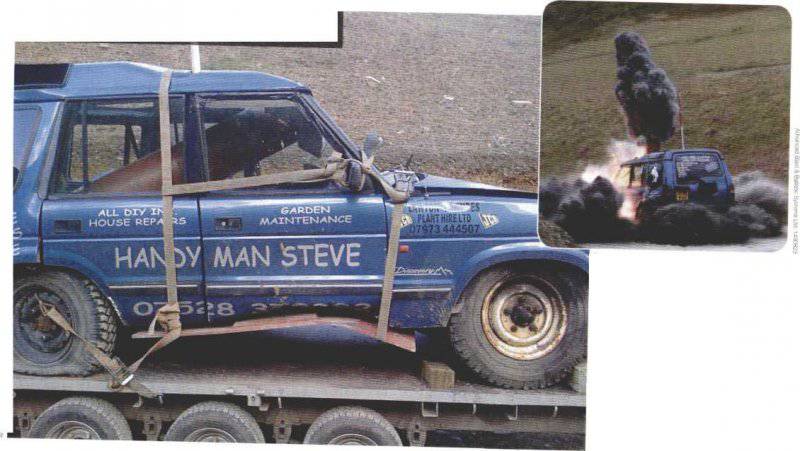
Deformation of a 15-mm bottom plate made of mild steel attached to the Land Rover Discovery car after an explosion on an 6-kg IED (left). You can see the release of gas from the counter-charge "chimney" installed immediately behind the driver and front passenger
Recent asymmetric conflicts in Afghanistan and Iraq have shown that buried improvised explosive devices (IEDs) are the preferred means of attacking Allied forces, outnumbered and technologically superior.
The use of IEDs for attacks on light and heavy armored vehicles led to a mutual battle between the designers of vehicle protection systems and the attackers (let's call them the rebels). The former are protecting their vehicles better and better, often using heavy solutions, while the latter are using ever larger charges. This suggests a simple conclusion: even if the armor and design of the vehicle can withstand the resulting forces that the detonating charge creates, then those sitting inside are unlikely to survive the impact of these forces. In response to this, the British company Advanced Blast & Ballistic Systems (ABBS) is developing the concept of active protection against IEDs and mines that will allow at least passengers to survive such attacks despite even significant damage to the vehicle.
The concept that underpins this technology was first identified by Roger Sloman, director of ABBS, after watching a high-speed video of the machine during blasting tests in April 2008 of the year. When watching the video, you could see that the initial shock wave passes through the machine in about 1 - 2 milliseconds, although there is no significant movement of the machine until the gaseous products and the release of soil are clearly visible on the sides of the machine. This happens only 8 milliseconds after the detonation of the charge. His conclusion was that the initial shock wave had little effect on the overall movement of the machine, and in fact the combination of the quasi-static pressure from the decomposition products of the explosive and the ejection of the soil made the car move upwards.
The delay in travel of 8 milliseconds opened up the possibility of using an active system that could reduce or counteract the upward acceleration of the car. Initial experiments were carried out by the private enterprise Sloman & Associates Ltd, the results of which confirmed that the idea was feasible. Although such a system is feasible, it must cope with explosions of varying power and differentiate them according to the duration of exposure and the total impulse. To counteract all these options, the developed system must adjust the response impact and its duration.
It should be noted that the application of the system of active attenuation of acceleration was previously considered impractical, the impact of the blast wave and the time of action were rated accordingly as too extreme and too fast. Whether this was related to the assumption that the initial shock wave and the corresponding reflected pressure were the main drivers for acceleration of the machine is unknown.
After collecting information on the results of their previous tests, the company turned to the British Ministry of Defense with a request for initial funding of this R & D. The Defense Ministry agreed to study this concept, most of the work was partly funded by the Laboratory for Defense Science and Technology (DSTL) with its scientific and technological center for booking and protection. After allocating funds, the company refined its concept, resulting in two principles of active protection system: VGAM (Vehicle Global Acceleration Mitigation - easing the overall acceleration of the vehicle) and VAFS (Vehicle Armored Floor Stabilization - stabilization of the armored bottom of the vehicle).
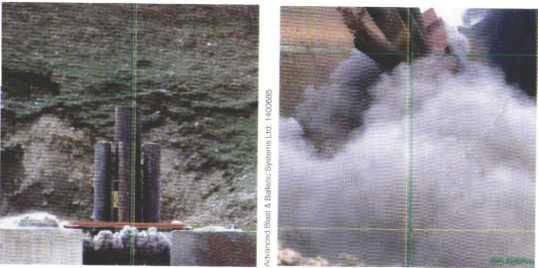
Two frames from a high-speed digital camera with a passive test recording. Approximately 2 milliseconds on the left, and 633 milliseconds on the right after the detonation of the charge, in the right picture you can see the maximum tossing of the machine, reaching the 3,5 meter
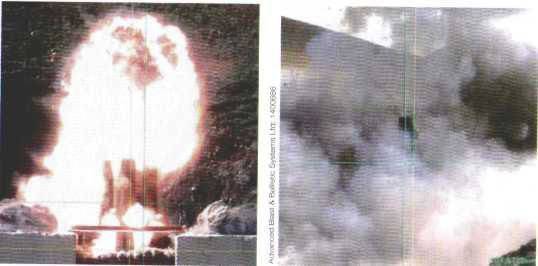
Two frames of high-speed shooting with a passive test recording. On the left, approximately 4 milliseconds and on the right 437 milliseconds after the detonation of the charge, the maximum machine toss was 1,04 meter
Power generation
Each of the concepts uses a certain type of power source; it may be a device equivalent to a cannon or a rocket engine. In the first case, the mass is ejected at high speed from the pipe, the recoil forces generated during the shooting act on the machine on which this device is installed. Such a device can work for a few milliseconds and generate a force value lasting several tens of milliseconds; the exact numerical value of the generated force depends on the charge (its mass and type) and the mass ejected.
Although the force / time curve is short, various devices can nevertheless be used to increase the period or adapt the response. However, the most mass-efficient method of generating an impulse is a special rocket engine. Ignition characteristics, thrust level, and engine running time have been specifically tuned to provide quick ignition and get a proper thrust / time curve; The resulting thrust time for each engine was up to 250 milliseconds. The rocket engine-based system is suitable for events lasting from 20 to 500 milliseconds and, like the mass ejection / rollback principle, several devices can be used to cover different explosion levels and time spans. In all likelihood, a combination of both types of sources of exposure can be used for the reasons explained later in this article.
The application of the concept of VGAM completely eliminates the acceleration of the whole machine up. The VGAM system uses several “strategically” placed engines installed on (or emitting gases from) the upper surface of the machine. The motors are activated according to data from a set of pressure and motion sensors connected to a high-performance signal processing system. The position and size of the initiated VCA will depend on which engine will work and on which value of impulse; the ignition sequence is controlled by the strength and timing of the signals generated by the sensor set and processed by the processor unit.
It is stated that the VGAM concept has a relatively simple design solution that can be applied to a wide range of military vehicles currently in service. The system requirements are such that the machine must be structurally strong enough to withstand the explosion itself and anti-acceleration forces. Although this system can be used on a variety of types of vehicles, from SUVs to main combat vehicles tanks, usually SUVs and VIP cars are lightly armored and resistant only to small explosive devices, so they require additional modification to withstand the detonation of larger IEDs.
In order to withstand large mines, an 2-3 class SUV machine of tons requires the addition of a bottom plate and a sufficiently solid floor design to prevent penetration and withstand the reverse pulse of the combined VAFS / VGAM system. This innovative system prevents the deformation of the floor and reduces the amount of total acceleration, which otherwise could seriously injure or kill passengers.
The basis of the VAFS concept is mainly to reduce the upward movement of the machine floor, but it also has a significant effect on the overall acceleration of the entire machine. The concept uses the so-called "column": in light vehicles, such as SUVs, one, and in heavy vehicles, for example, in armored personnel carriers, several "columns". They are connected directly to the bottom plate or installed on the floor, which is connected to this plate through a load sharing structure.
The columns either contain engines or serve as their supports at the top of the machine, they are aligned along the longitudinal axis of the machine and pass through the cabin space to divert gases through the roof of the car. The floor and the bottom are not only rigidly connected, but the space between them is filled with collapsing energy-absorbing structures, for example, from foam metal or cellular aluminum. Again, the concept uses a set of sensors that provide the processor unit with data. When undermining the IEDs and after processing the data from the sensors, the corresponding number of engines of a certain type ignites, and the further impact on the machine depends on the installation method. In the first case, the prevention of movement of the bottom plate is provided mainly by the engines, and in the second case, the floor moves down and away from the passengers in the direction of energy absorbing structures, while the bottom bends and moves upwards into the space available to it, preferably without contact with the internal floor of the car.
The latter case is the preferred option, since the movement of the floor down eliminates a direct impulse of force directed upwards to the feet of the passengers if they are in contact with the floor or are connected in some way with it. This configuration also prevents upward movement at potentially lethal speeds of any loose objects in contact with the floor, such as backpacks, weapons, ammunition, etc.
Machines with V-shaped hulls have several drawbacks that VAFS technology can level out to some degree. The bottom plate on such machines, as a rule, is located at a very acute angle, and this limits the available internal space and increases the height of the machine and its center of gravity. Reducing the internal space in any vehicle adversely affects, and especially in the car carrying personnel. Secondly, by increasing the height of the vehicle, you increase its silhouette, which is a larger target. Finally, lifting the center of gravity, you thereby increase the likelihood of turning the machine when a sharp turn or move on rough terrain. The use of VAFS technology allows you to increase the angle of the bottom of the bottom plate of the machine, giving it a double-angled profile. The modified leaf profile reduces the height of the machine and the center of gravity, which reduces the silhouette and the likelihood of its turning over. It also allows you to lower the floor in the car and get either the same or even greater internal volume and height.
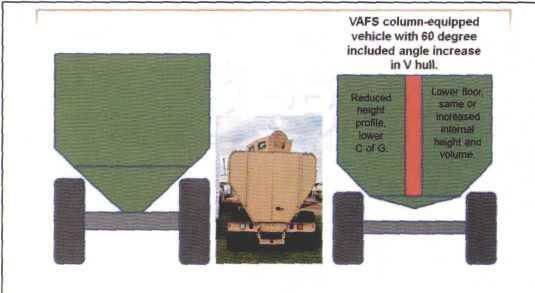
VAFS technology demonstrates the fundamental advantages of the construction of active support for the bottom plate
Mr. Sloman touched on the system security issues regarding the sensitivity of the rocket fuel used and unintentional activation of the system. Taking into account the characteristics of the engine and the mass ejection system, rocket fuel is a common blend compatible with current British requirements for insensitive munitions. The mass ejection system uses an existing commercial, but fully compatible with insensitive ammunition energy source.
In order to reduce the ballistic effect on the active parts of the engines and eliminate the penetration of high-pressure gases and gaseous decomposition products of rocket fuel with high temperatures, two strategies were chosen for the habitable compartment. The first is that the energy components of the system are placed between the floor and the bottom plate to accommodate all the gases emitted; and secondly, more durable material is applied to the jet engine housings so that they can withstand the ballistic effect.
The company ABBS states that in the case of spontaneous operation of the system, the result depends on the number of initiated engines. If a single engine is ignited, it will forcefully lower the corresponding zone of the machine, while the impact on the internal components of the machine is minimal due to its suspension and weight. With the simultaneous operation of all engines, the machine can be thrown down by forces equivalent to the forces necessary to stop the vehicle from moving up in the event of an explosion at the VCA. Although the forces created are similar to the forces undermining the IEDs, they are directed in the opposite direction, and the machine’s suspension allows them to “fit” in a relatively long period of time. In the second case, if the passengers are sitting on explosion-proof seats, there is a very small risk of injury, even if the suspension is compressed to the maximum or its stroke is exceeded so that the bottom forcefully sinks to the ground.
During the March tests (2013 year) three tests were carried out. Two tests were carried out on the model of the machine: one with the engines operating in the active mode, and the second with the engines in the passive state, without their ignition.
In the third, quickly prepared test, the modified Land Rover Discovery was equipped with a basic 15-mm low carbon steel bottom plate and one VAFS / VGAM engine. All tests were carried out under conditions similar to the NATO standard STANAG 4569, but using 6-kg pancake made of plastic hexagen, buried (to a depth of 100 mm) in unsaturated sand, which is usually used to accelerate the testing process.
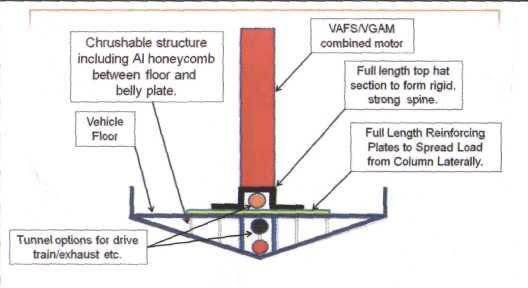
Combined VAFS / VGAM engine designed for light vehicles and low ground clearance SUVs
In the first two tests, one large VAFS engine and six VGAM engines were used; The VAFS engine was installed in the center, and VGAM engines were placed around it. These engines were kept in a steel frame consisting of an 4-mm top sheet and a series of bottom plates (15 mm, 10 mm and 25 mm), the sidewalls of the frame were made of two steel I-beams. A porous, energy-absorbing material was placed between the upper and lower sheets. The entire test stand was installed on oak logs and hung at a height of 300 mm above the pit with sand with a charge placed under the center of the stand. In the test with the car, an identical charge was placed in the pit in the same way, the height of the bottom plate was also 300 mm. This time, the charge was installed on the centerline immediately behind the driver and front passenger seats.
During the detonation during the passive test, the stand was raised to the height of the 3,5 meter, its central part directly above the charge reached the peak speed of 28 m / s after the 0,5 millisecond after detonation. The constant deformation of the thick bottom sheet was zero, although the porous structure was compressed on 10-20 mm, which demonstrates the presence of some elastic deformation.
In the active test, the stand was raised by an explosion to the height of 1,04 m, the initial peak speed of 7,7 m / s near the center of the structure was reached in 4,5 milliseconds. The bottom plate was shifted from the top of the test bench and deformed in its central part by 180 mm down, while the minimum compression of the porous structure did not exceed 5 mm.
The active test was considered successful, he showed that the initial acceleration rate can be significantly reduced and the overall impulse is largely neutralized. In fact, the test was not carried out as planned. It was originally planned to start six small engines in a slow-motion sequence in order to get the “force / time” curve, but then decided to initiate all the engines at the same time. After the test, it was suggested that if the initial ignition sequence were applied, then the general acceleration and the resulting throwing up on the 1,04 m could be completely eliminated.
In the third test with a Land Rover Discovery car, the front part of the car was thrown to the peak height of the 2 meter, and the rear part to the 1 meter. The bottom sheet was pushed up and deformed by almost 150 mm in the area of the front foot recesses and was not deformed in the area of the rear foot recesses. In fact, the car body was not damaged due to the direct impact of the blast wave; with the exception of two dropped out windows on the left side due to the elastic deformation of the hull, all the glasses remained in place.
The test was considered successful, although the engine generated only half the magnitude of the pulse with half the duration compared to the final version of the system. As expected, the final version will use a more powerful engine or a set of engines with a smaller diameter.
Using the results of the tests, the company is currently evaluating various design solutions and conducting additional tests in order to obtain additional data on the characteristics in order to further clarify and determine the mass of the structure. In order to promote its products and clarify all specific requirements, the company is currently consulting with major manufacturers of military equipment in Europe and the USA. The company is also at the stage of obtaining additional funding from investors for finalizing the concept to an industrial design and marketing technology worldwide.
The company considers the markets of the USA, Europe and the Middle East as potential sales markets, although it also looks towards India and the rest of Asia. The company does not limit the use of technology only to the military sphere, it also intends to enter the commercial market.
When asked whether this system will be in demand on the market after the expected withdrawal of troops from Afghanistan in 2014, the company responds that although the Western military and NATO forces may consider IEDs as a reduced, low-priority threat, the use of IEDs and mines will not disappear.
The perceived use of IEDs and mines in the long run and the advantages that an active system provides means that the need for such systems is unlikely to fall. The “long life” of this threat means that the constructive standards for such systems need to be clarified and agreed, first of all, it concerns the NATO standard STANAG.
To protect intellectual property, the company in 2008 year patented the basic concept of generating and applying opposing forces in order to counteract the forces of the blast wave. In addition to this main patent, the company has from five to ten other patents describing the VAFS technology technology and a detailed system design. If necessary, the scope of current British patents can be extended to the global level. The company is currently looking for partners for further global technology coverage.
The current situation is that all the basic concepts of the system have been tested, all specific design options are available that could meet any reasonable requirement. For manufacturers of armored vehicles and military components, it remains only to decide what type of protection and what level they would like to build into their basic machine designs or add as an upgrade.
Materials used:
Jane's International Defense Review
www.advanced-blast.com
Information